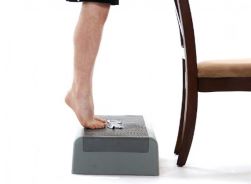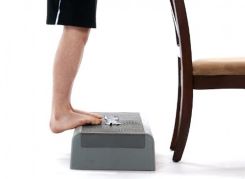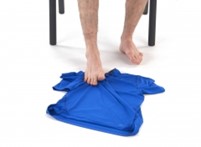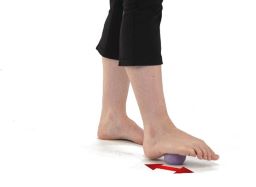Note: The plantar fasciitis exercises and/or stretches in this blog are not intended to replace the advice of your clinician. Starting a new exercise, stretch, movement, or activity may result in some expected stiffness and soreness. If you are unsure, please speak to your clinician before attempting any of the suggestions below.
Is your foot pain caused by plantar fasciitis?
You may be experiencing plantar fasciitis if you have foot or heel pain:
- During or after activity such as walking or playing a sport
- In the morning or after sitting for a long time
- When doing activities on your feet for long durations
- After starting a new activity or increasing activity duration
Learn more about what plantar fasciitis is and simple exercises you can use to help manage pain at home.
The plantar fascia is a thick band of tissue running along the bottom of the foot. It functions to support the arch, absorb force, protect structures deeper in the foot, and provide information on where our body is in space. Plantar fasciitis is a reactive condition of the plantar fascia, often caused from overload. It is one of the most common causes of foot and heel pain impacting all age groups and can be very limiting.
Imagine moving a couch with 3 friends, but one isn’t strong enough, one isn’t flexible enough, and the other cannot balance, this would put lots of load on you! This is similar to what can happen to the plantar fascia. There are other structures in the body that help it function properly, and if one or more aren’t helping enough, or at all, the plantar fascia can become painful as it takes on too much workload. Plantar fasciitis can also result from a new activity, new footwear, or other causes of increased stress on your foot.
Applying different strategies to address the root of the issue is usually the most effective option to help plantar fasciitis resolve and prevent reoccurrence. There is no “perfect solution”, but there are multiple ways to approach treatment and often combining methods works best.
Simple exercises to start at home
Strengthening and stretching the muscles of the calf and foot can help you move better and may provide pain relief. By making the supporting muscles stronger, the plantar fascia doesn’t have to work so hard.
Try these 3 exercises to help support the plantar fascia. Also consider these as a warm up before activity.
1. Calf raises: Start by standing on a step, secure stool, or even on a flat ground. Raise your heels up so that you’re on the balls of your feet (your tippy toes) and slowly lower your heels down to the ground. Work up to 3 sets of 10 repetitions.
2. Towel scrunches: In a seated position, place a towel or loose piece of clothing under your foot. Use your foot and toes to scrunch and “grab” the towel. Hold, then release and repeat. Aim for 30 – 60 seconds and do up to 3 times per day.
3. Massage the plantar fascia by rolling your foot over a small hard ball. Do this for 30-60 seconds at a time. Ideally, first thing in the morning or after you have been on your feet for long periods. This helps to reduce feeling of tightness and may provide some pain relief.
When to seek treatment from a physiotherapist
If you find self-treatments at home are unsuccessful, are unsure as to whether something is helping, or you would like to seek further treatment and advice, physiotherapy can be a great option. Physiotherapists have a deep understanding of the human body and can go through a full assessment with you to help determine what might have led to plantar fasciitis. More importantly, they can provide personalized treatments to help reduce pain, resolve symptoms, and prevent reoccurrence. This may include manual therapies, exercises, as well as insoles or orthotics which provide further arch support for the feet.
Plantar fasciitis can take time to improve, but it is not something you need to suffer with long-term. Plantar fasciitis is very common, so there are lots of helpful treatments and strategies to manage it. Reach out to a Lifemark physiotherapist if you require assistance and support.
If you would like to schedule an appointment with a physiotherapist to assess your foot pain, check out our locations page to find a pt Health clinician near you.
This blog originally appeared on Lifemark.ca and was written by Maddie Ryan, a physiotherapy student at The University of Alberta.




